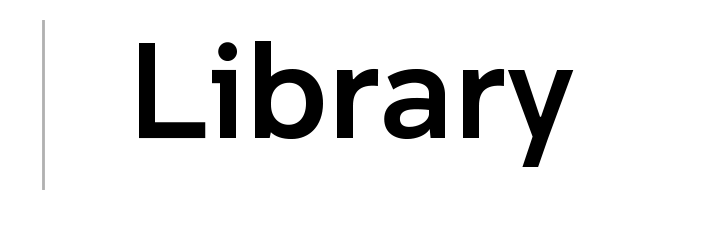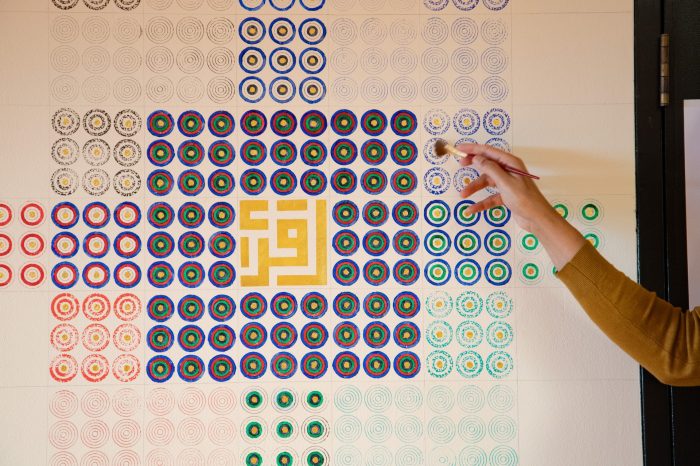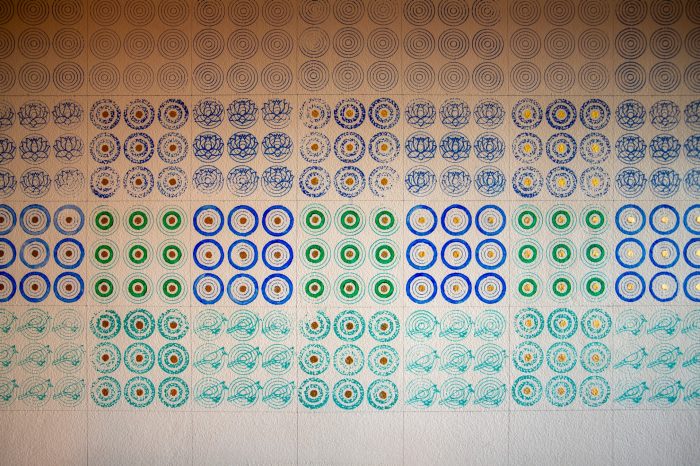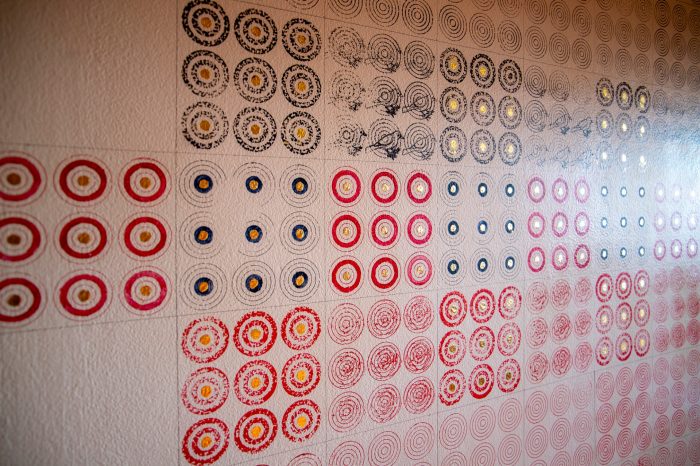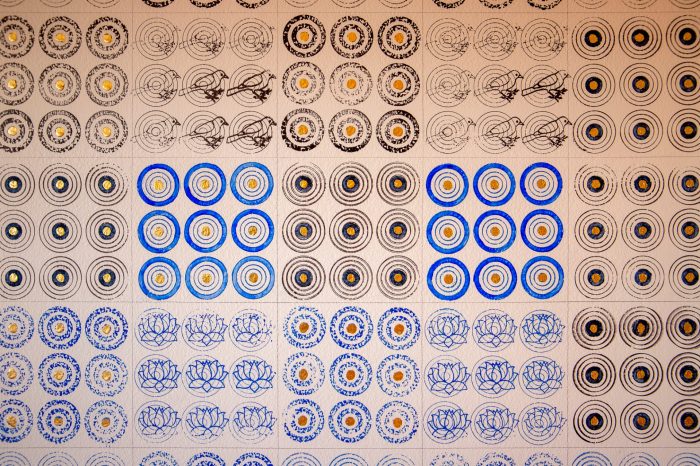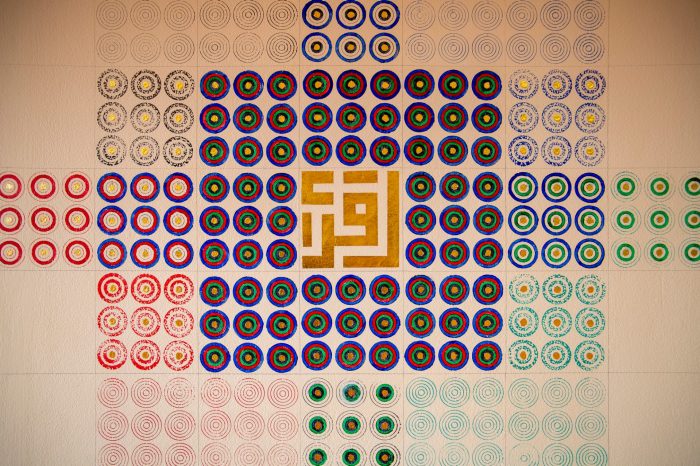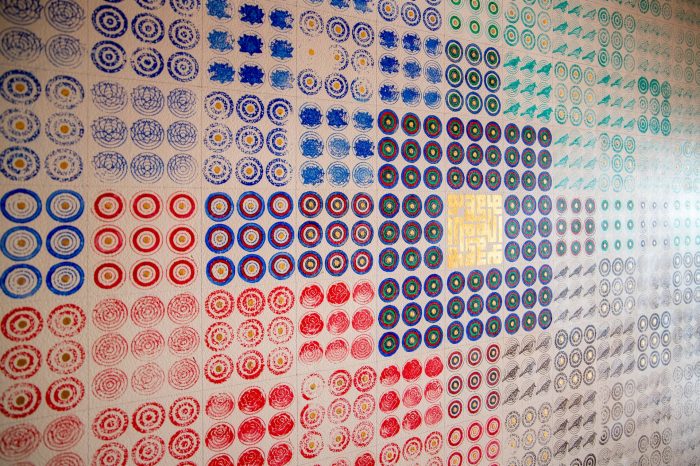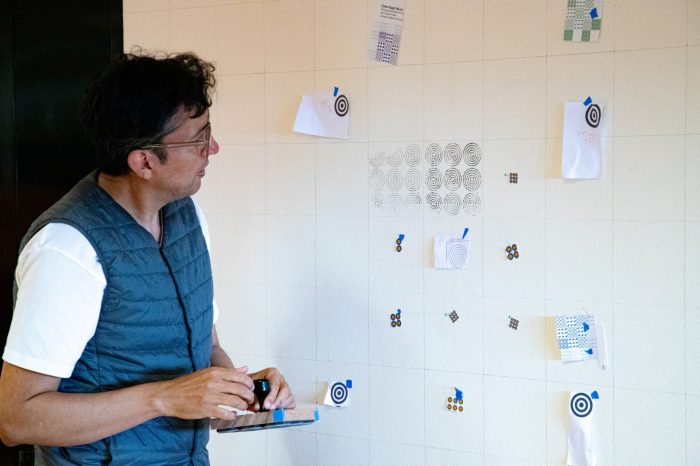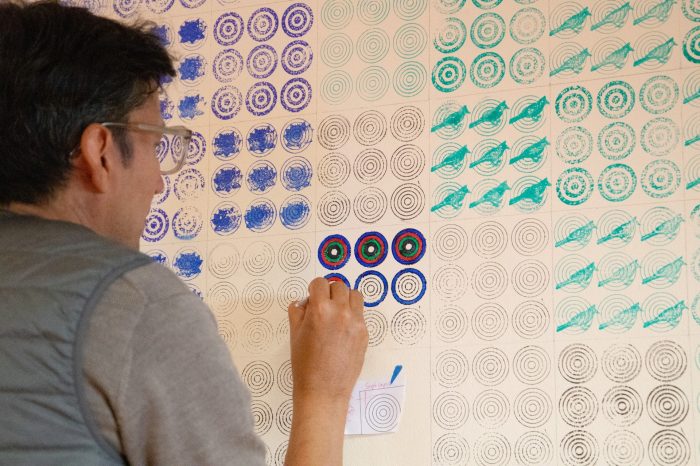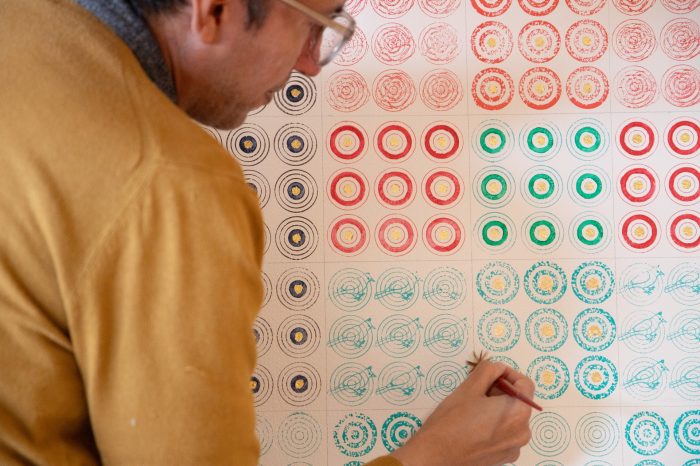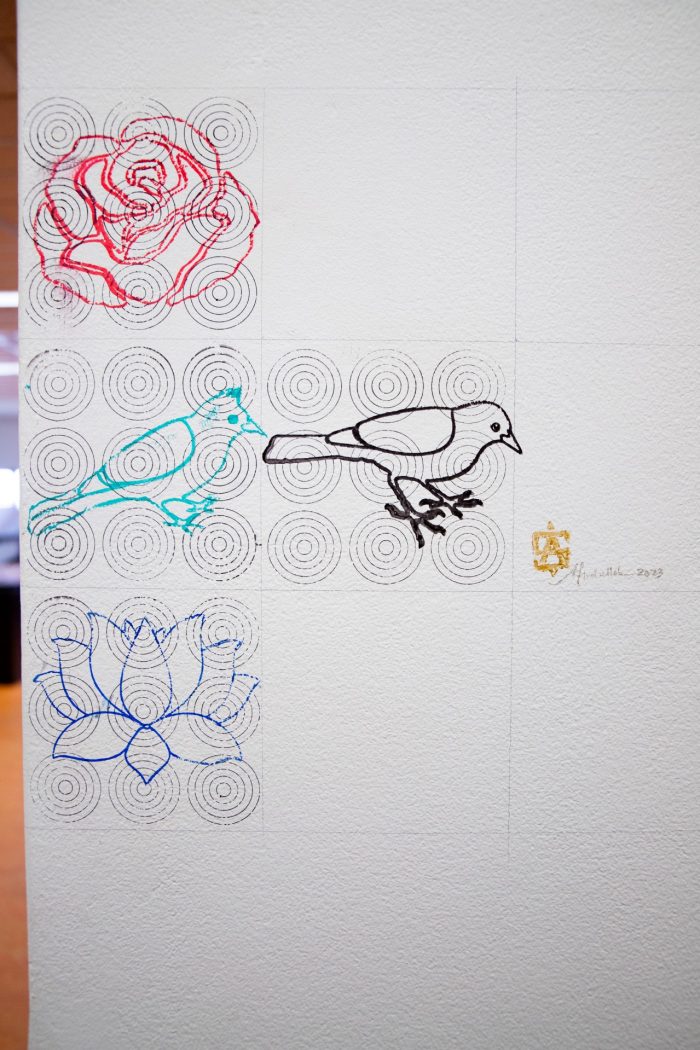Alumni Mural program: Abdullah M. I. Syed
Abdullah M. I. Syed’s mural Chahār Bāgh: Garden of Knowledge engages the Islamic design of Chahār Bāgh, meaning "Four Gardens”, which reflects Heaven on Earth. This public mural is in the lift foyer of Level 7, UNSW Main Library.
When:
September 2023 - 2026
Where:
Main Library, Level 7 lift foyer
Recognised for its practical quadratic pattern design, mystical symbolism, cultural significance, and connection with nature, Syed’s Chahār Bāgh mural transforms the Library space into a painted garden of knowledge. In this mural, Syed combines contemporary drawing and painting methods with traditional craft knowledge learned from his mother and local artisans in Pakistan, including woodblock fabric printing of Sindhi Ajrak (blue), Ralli (patchwork) and South Asia miniature painting techniques.
To complete this intricate mural, Syed painted and hand-stamped motifs such as flowers, birds, and concentric circles. Flowers such as rose and lotus represent love, life, and enlightenment. The nightingale motif connotes a harbinger of hidden knowledge, beauty, and truth-telling, and the myna bird is a bridge between Australia and the artist’s native home of Pakistan. The colour-filled ripples symbolise consciousness, growth, and the blossoming of ideas. These circles form the symbolic rivers of knowledge, flowing through the floor’s elevators, aligning with the horizon, and promoting ripples of shared understanding. As the interior mural meets the external windows overlooking Sydney, viewers extend their perception out to the sky and the universe beyond - where imagination meets reality - situating the Library as a place for everyone to share, learn, and grow.
As a cross-cultural bridge, Chahār Bāgh: Garden of Knowledge promotes diversity and inclusion, inviting visitors to read, contemplate and seek knowledge within UNSW Library.
Dr. Abdullah M.I. Syed is an artist, designer and scholar, whose practice champions the power of storytelling from a cross-cultural perspective. Syed is inspired by his Pakistani Muslim heritage, traditional arts and crafts, material culture, spirituality, nature, and the influences of his everyday experiences. Working across sculpture, video, textile, photography and performance, his art practice serves as an archival form of manzoom muzahamat (poetic resistance), a form of activism that seeks to counter socio-political conflicts, apathy, and disillusionment through ideas of shared vulnerability, self-love, care, and storytelling.
In a career spanning three decades, Syed has exhibited and performed nationally and internationally in venues such as the Art Gallery of New South Wales, Sydney; Asia Society Museum, New York; TIFF Bell Lightbox, Toronto; Devi Art Foundation, New Delhi; the National Art Gallery, Islamabad and the Mohatta Palace Museum, Karachi. His public artworks can be found throughout Sydney, with a newly installed public artwork at the new Australian Embassy in Washington DC, USA.
Syed completed a PhD in Art, Media and Design from UNSW Sydney in 2015.
Abdullah M. I. Syed is represented by Gallery Sally Dan Cuthbert, Sydney. The artist would like to acknowledge and thank Tia Madden for her assistance on this mural project.
Accessibility: UNSW Main Library is wheelchair accessible. Audio-described guides, braille exhibition guides, and large-text artwork labels in English and Urdu are available on Level 7.
Video
Image gallery
Audio guide
Abdullah M. I. Syed audio-describes the mural Chahār Bāgh: Garden of Knowledge. The approximate run time is 8 minutes.
-
Transcript of audio description of mural
Chahār Bāgh: Garden of Knowledge. Mural by Abdullah M. I. Syed. Commissioned and completed in 2023 as part of the UNSW Library Alumni Mural Program. Courtesy of the artist and Gallery Sally Dan-Cuthbert, Sydney.
My name is Abdullah M. I. Syed, I am an artist, designer, scholar, and the creator of the UNSW Library level 7 mural Chahār Bāgh: Garden of Knowledge.
This mural engages the Islamic design of Chahār Bāgh, meaning "Four Gardens”, which reflects Heaven on Earth. Recognised for its practical quadratic pattern design, mystical symbolism, cultural significance, and connection with nature, the Chahār Bāgh of this mural transforms the Library space into a painted garden of knowledge. The mural combined contemporary drawing and painting methods with traditional craft knowledge learned from my mother and local artisans in Pakistan, including woodblock fabric printing of Sindhi Ajrak (meaning blue), Ralli (meaning patchwork) and South Asia miniature painting techniques.
Chahār Bāgh: Garden of Knowledge combines motifs inspired by South Asian miniatures, including flowers (rose and lotus) and birds (nightingale and myna), with wood-blocked 24-carat gilded text and concentric circles (ripples) symbolising the four heavenly rivers of Chahār Bāgh. Metaphorically, these rivers of knowledge flow through the floor’s elevators, promoting ripples of inclusion and shared understanding, inviting visitors to contemplate and seek knowledge. As the interior mural meets the external windows overlooking Sydney, viewers extend their perception out to the sky and the universe beyond - where imagination meets reality - situating the Library as a place for everyone to share, learn, and grow.
As an artist, I tell stories from a cross-cultural perspective. I am inspired by my Pakistani Muslim heritage, traditional arts and crafts, material culture, spirituality, nature, and the influences of my everyday experiences. I am a PhD graduate of UNSW College of Fine Arts (now UNSW Art & Design) with an interdisciplinary art practice that spans drawing, sculpture, video installation, photography, performance, text art, and public art commissions.
Chahār Bāgh: Garden of Knowledge is a mural painted across the full length of opposing north and south walls of the level 7 lift foyer area. The mural is interspersed by three black elevator doors and one large metallic elevator button on each side. A narrow, totem-style digital sign punctuates the centre of the north wall. A bank of windows at the apex of the two walls facing west invites audiences to peer out over the Sydney horizon. These windows bring natural light to the mural area, shifting in hue as the sun travels across the sky throughout the day.
At the base of the mural is a grid pattern: fifteen-by-fifteen centimetre squares meticulously hand-drawn onto the white walls using lead pencil. This grid acts as a drawn, architectural frame that stretches from the ceiling to the floor and across the full length of both walls. Within the gridlines is a series of repeating patterns in ink created with square woodblock stamps. The predominant pattern is five concentric circles in a three-by-three configuration. The circles appear like ripples of water, flowing outwards with perfect symmetry.
Using a woodblock stamp, I applied four colours of ink - black, red, blue, and green. These colours form 'quadrants’, with large sections of wall dedicated to the equal division of these four colours in an alternating sequence. For example, in one two-metre-square section, the top left is entirely blue, the top right is green, the lower left is red, and the lower right is black.
Throughout the mural, I applied the concentric circle stamp with varying pressure: the ink is thick and concentrated at the centre line of the wall, gradually thinning and fading out towards the ceiling and the floor. This results in a distinct horizontal line running across the entire work, which meets the skyline through the windows. I further accentuated this horizon line by hand painting individual rings in the concentric circles to emphasise the colour of each quadrant. The middle of each circle is filled with luxurious gilded gold. When the sunlight shines on the wall, and especially when the sun is setting in the west, the individual gold dots shines like a constellation of stars.
In two separate sections of the mural - one on the south wall and one on the north wall - the subtle quadratic pattern intensifies with an accumulation of colour and detail. This includes additional hand-painted circles, gilded gold dots, and the overlaying of woodblock motifs on top of the concentric circle prints. These motifs are applied generously in ink, including the outline of roses, lotus flowers, nightingale birds, and myna birds. The myna bird, commonly found throughout Australia, is native to South Asia. At the zenith of this detail is one square dedicated solely to a gilded-gold calligraphic emblem, written in Arabic Kufic script. This emblem sits elegantly within the grid, surrounded by colourful-painted concentric circles, with an emphasised patterned gridline extending vertically and horizontally outwards.
From a distance, the mural appears as an organised play of four colours, accentuated at the central horizon line with bursts of intensity in defined sections. As one moves closer to the complexity of the design, and the unique detail of the printed woodblock patterns become apparent. The arrangement is structured, but the ink expresses the minor inconsistencies of intricately handcrafted work. The flower and bird motifs convey a sense of nostalgia and tenderness, and the gilded-gold calligraphy is both striking and distinguished.

